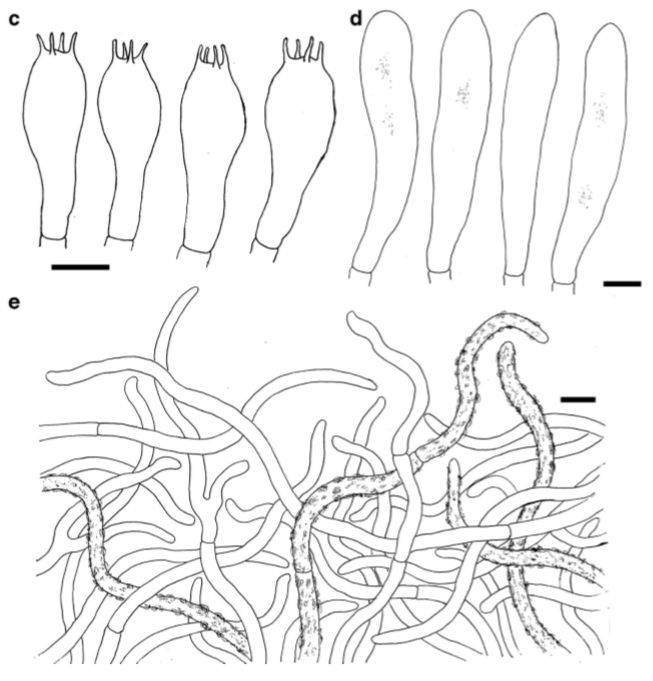Russula amethystina subsp. tengii G.J. Li, H.A.Wen& R.L. Zhao
Fungal Names number: FN570231 Facesoffunginumber: FoF 02058
Etymology: named after Prof. S.C. Teng, in honor of his contribution to the taxonomy of Russula.
Holotype: HMAS 253336
Basidiomata small- to medium-sized. Pileus 43–52 mm in diam., hemispheric when young, plano-convex, expanding to applanate when mature, rarely center slightly depressed with age, not striate, sometimes cracked, slightly viscid when wet, peeling 1/4–1/3 from the edge, lilac to vinous tinged with intermixed with brown vinous tinged with Brownish Vinaceous (XXXIX5′″b), Light Russet-Vinaceous (XXXIX1′″d) to Haematite Red (XXXIX5″m), reddish tinge of Pompeian Red (XIII3′i) in center, Dark Vinaceous-Brown (XXXIX5′″k) and Vinaceous-Brown (XXXIX5′″i) intermixed with Pale Brownish Drab (XLV5′″′d) towards the margin when dry. Lamellae slightly subfree, 2–5 mm in height, 13–16 pieces per cm in the edge, rarely forked near the stipe or in the middle, interveined, with ocherous, yellowish tinged with Light Ochraceous-Salmon (XV13′b), Light Ochraceous-Buff (XV15′d) to Ochraceous-Buff (XV15′b); lamellulae absent. Stipe 5.5–6.8×0.9–1.5 cm, subcylindrical, surface dry, rugulose longitudinally, dull, without annulus, slightly attenuate upwards, White (LIII), a tinge of Pale Yellow–Orange (III15f) when injured and dry, stuffed first, becoming hollow when old. Context up to 1–2 mm at the center of the pileus, White (LIII), fragile, with iodoform Odour; taste mild. Spore print Ocher (Romagnesi IIId–IVa). Basidiospores [100/10/8]7.4–8.7(–9.2)×6.2–7.5(–8)μm, Q=(1.06–) 1.10–1.28 (–1.34), (Qm=1.20±0.06), hyaline, mostly broadly ellipsoid, rarely subglobose or ellipsoid; ornamentation cristulate to subreticulate, composed of amyloid warts that linked as small crests and ridges, forming a nearly complete to complete network, rarely inter mixed with isolated verrucae, warts 0.5–0.8 μm in height; supra hilar area distinctly amyloid. Basidia 30–40×7–10μm, 4-spored, sterigmata 3– 6μm long, hyaline, sometimes yellowish in KOH, subclavate to clavate, rarely cylindrical. Pleuroystidia scattered, 55– 100×8–13μm, distinctly projecting 20–60μm beyond the basidia, subfusoid to subcylindrical, sometimes clavate to subclavate, apex obtuse, thin–walled, contents rare, granular to crystal, weakly gray in sulphovanillin (SV). Cheilocystidia not observed; lamellar edge sterile. Subhymenium a cellular layer 20–35μm thick composed of inflated cells 7–13μm in diam., hyaline, sometimes pale yellowish in KOH. Pileipellis composed of epipellis and subpellis; epipellis a trichoderm 125–150μm thick, composed of thin-walled, cylindrical hyaline hyphae 3–6μm wide; primordial hyphae 4–7μm wide, with heteromorphous-opalescent inclusions and acidresistant incrustations,septate,clavate to cylindrical,apexobtuse; subpellis a cutis 100–120μm thick, composed of gelatinized, interweaved hyaline hyphae 2–6μm wide, pileocystidia not observed. Stipitipellis a cutis, composed of filamentous hyphae3–6μm in diam.,interweaved within flated cells 10–15 μm in diam., hyaline, some hyphae pale yellow in KOH; caulocystidia absent. Clamp connections and lacticiferous hyphae absent from all tissues.
Habit and habitat. Single or small groups in coniferous forest (dominated by e.g. Pinus densata var. pygmaea, P. yunnanensis, Picea likiangensis var. likiangensis and P. likiangensis var. linzhiensis) at 2000–3500 m altitude.
Distribution. China (Xizang and Yunnan). Season. July and August.
Material examined: CHINA, Yunnan Province, Lijiang City, Yulong County, Lijiang Alpine Botanic Garden, N27°05′ E100°10′, elevation 3447 m., 17 July 2014, collector Guojie Li and Yaning Wang, 14252 (HMAS 253336, holotype); Ibid., elevation 3258 m., collector Guojie Li and Yun Yu, 14075 (HMAS 271033); Ibid., elevation 3471 m., collector Guojie Li and Mingjun Zhao, 14188 (HMAS 271034); Ibid., elevation 3274 m., collector Guojie Li and Shuhua Jiang, 14088 (HMAS 271161); Ibid., collector Guojie Li and Yunlong Li, 14187 (HMAS 271048); Chuxiong City, Nanhua County, Zixishan Forest Park, N25°01′ E101°32′, elevation 2134 m., 20 August 2013, collector Weilai Lu, Tiezheng Wei and Zhenping Yang, 354 (HMAS 252864); Xizang Autonomous Region, Nyingchi Prefecture, Mainling County, roadside of National Road 318 to Nang County, N29°12′ E94°11′, elevation 2994 m., 12 August 2013, collector Tiezheng Wei, Xiaoyong Liu, Jianyun Zhuang and Tian zhou Li, 3701 (HMAS 253216); Ibid., 3698 (HMAS 253241).
Notes: The combination of a violet-tinged pileus without olive green, bluish gray or entirely yellow tinges, deep yellow spore print, pileipellis with primordial hyphae, absence of pileocystidia, and coniferous habitat assign this taxon into Russula amethystina Quél. of Russula subgenus Incrustatula Romagn, Russula section Amethystinae Romagn. (Romagnesi 1987). The phylogenetic result also supports the placement (BS 97 % and PP 1.00). These suggest R. amethystina subsp. tengii is very closely related to R. amethystina subsp. amethystina, which however, has easily distinguishable higher basidiospore ornamentation composed of mostly isolated. (basidiospore ornamentation height: R. amethystina subsp. tengii 0.5–0.8μm vs R. amethystina subsp. amethystine 0.8–1μm) Romagnesi 1967; Sarnari 2005; Kränzlin2005). Because the basidiospore of R. amethystina subsp. tengii is almost the same as that of R. turci Bres., the morphological distinction between the two closely related species is becoming blurred. It is still clear in the distinction among R. amethystina, R. turci, and R. roseipes Secr. ex Bres. phylogenetic analyses. The high phylogenetic BS/PP values and the only obvious morphological difference of basidiospore ornamentation effectively supported that R. amethystina subsp. tengii is a subspecies of R. amethystine.

Basidiocarps and microcharacters of Russula amethystina subsp. tengii (holotype) a Basidiocarps b Basidiospores c Basidia d Pleurocystidia e Epipellis. Scale bars: a=1 cm, b–e=10μm

